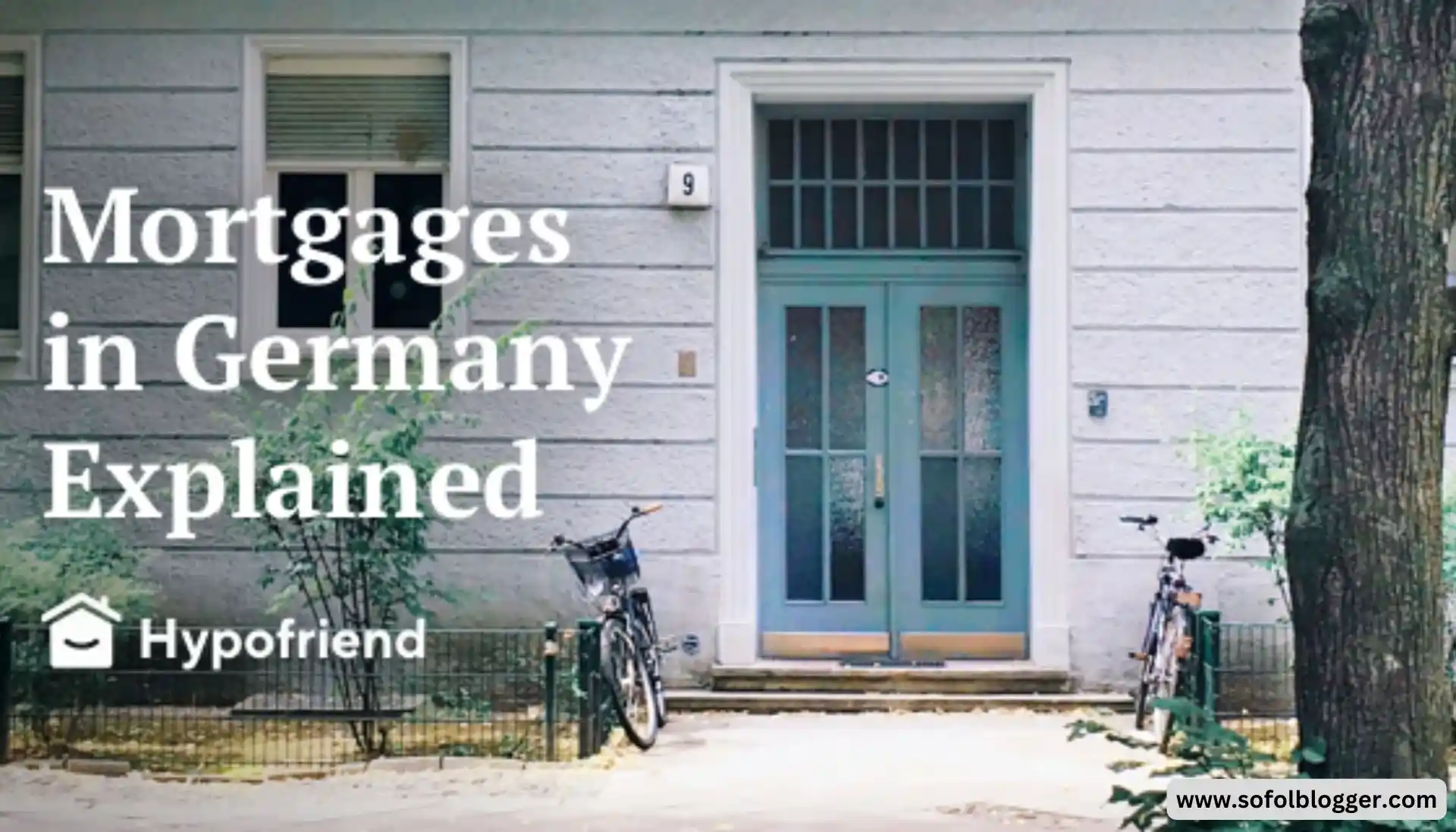home loan in Germany is a relatively straightforward process, but it requires preparation and a good understanding of the country’s mortgage system. If you’re looking to obtain a loan of $100,000 (about €93,000), this guide will walk you through the necessary steps.
1. Understand the German Mortgage System
Germany’s mortgage system is unique in several ways. For instance, most German home loans are fixed-rate mortgages, meaning the interest rate is locked in for the entire loan term. This provides stability and predictability in repayments. Additionally, most German lenders will offer up to 80% of the property value, meaning you’ll need a down payment of around 20% to secure the loan.
Key Features of the German Mortgage System
1. Fixed Interest Rates (Zinsbindung)
One of the most notable features of the German mortgage system is the prevalence of fixed-rate mortgages, known as Zinsbindung. These mortgages come with a fixed interest rate for a specified period, typically ranging from 5 to 30 years. This provides borrowers with stability, as their monthly payments remain the same for the duration of the fixed-rate period.
Borrowers in Germany often choose longer fixed-rate periods, which is unlike some other countries where variable-rate loans are more common. This is particularly appealing for those seeking long-term financial predictability.
2. Variable Interest Rates (Variabler Zinssatz)
Although less common, variable-rate mortgages (Variabler Zinssatz) are also available in Germany. These loans have interest rates that can change periodically, depending on the financial market. While variable-rate mortgages can initially offer lower interest rates than fixed-rate loans, they carry the risk of increasing payments if market rates rise.
For risk-averse buyers, fixed-rate loans tend to be more attractive, but some may opt for a variable rate if they expect interest rates to decrease in the future.
3. Annuitätendarlehen (Amortizing Loans)
The most common type of mortgage in Germany is the amortizing loan (Annuitätendarlehen), where the borrower repays both interest and principal over time. In the early stages of the loan, a larger portion of the payment goes toward interest, while in later years, more goes toward paying off the principal. This structured repayment method ensures the loan is paid off by the end of the term, typically within 20 to 30 years.
4. Tilgungsdarlehen (Repayment Loans)
Another option is the repayment loan (Tilgungsdarlehen), which differs from an annuity loan in that the principal repayment remains constant throughout the loan term, while the interest payments decrease over time. This type of loan is less common but can be advantageous for borrowers who prefer steady principal payments.
Mortgage Terms and Loan-to-Value Ratio
1. Loan-to-Value Ratio (LTV)
In Germany, most banks require a significant down payment from homebuyers, with loan-to-value (LTV) ratios generally ranging from 60% to 80%. This means that borrowers must typically provide 20% to 40% of the property’s value as a down payment. Higher LTV ratios are available in some cases, but they may come with higher interest rates or require private mortgage insurance.
2. Loan Terms
Mortgage terms in Germany tend to be longer than in some other countries. It is common to find loan periods ranging from 10 to 30 years, with many borrowers opting for terms that allow them to lock in interest rates for extended periods. At the end of the initial fixed-rate term, borrowers have the option to refinance or renegotiate their loan terms based on the remaining balance.
Special Features of the German Mortgage System
1. Bausparvertrag (Building Society Contract)
Germany has a unique savings system known as the Bausparvertrag, or building society contract. This is a savings plan where individuals contribute to a housing savings account over time. After reaching a specific savings target, the participant becomes eligible for a low-interest mortgage. Many Germans use this system as a way to save for a future property purchase and secure favorable mortgage conditions.
2. KfW Loans
The KfW Bank, a state-owned development bank, offers special mortgage programs for energy-efficient homes or properties undergoing eco-friendly renovations. These loans often come with favorable terms and subsidies, making them attractive for buyers looking to invest in sustainable housing. KfW loans can be combined with traditional mortgages to create a more cost-effective financing package.
3. Early Repayment (Vorzeitige Rückzahlung)
Unlike in some countries, early repayment of a mortgage in Germany can come with penalties, particularly if it occurs during the fixed-rate period. Known as the Vorfälligkeitsentschädigung (prepayment penalty), this fee compensates the lender for the loss of interest income. The cost of this penalty varies, depending on how early the loan is paid off and the remaining loan balance. However, many loans allow for small annual overpayments without incurring a penalty, providing some flexibility.
Factors Influencing Mortgage Approval
Mortgage approval in Germany is based on several key factors, including:
- Credit Score: Lenders assess the borrower’s creditworthiness through their Schufa credit score, which is the German equivalent of a credit report. A good credit score is essential for securing favorable mortgage terms.
- Income and Employment Stability: Borrowers must demonstrate a stable and sufficient income to cover monthly mortgage payments. Lenders prefer applicants with long-term employment contracts or steady income from self-employment.
- Debt-to-Income Ratio (DTI): Lenders will calculate the borrower’s debt-to-income ratio to ensure that they are not overburdened by their mortgage. Typically, a DTI ratio below 35% is considered acceptable.
- Down Payment: A larger down payment can improve the chances of mortgage approval and lead to better interest rates.
Steps to Obtaining a Mortgage in Germany
- Assess Your Financial Situation: Calculate your budget and determine how much you can afford to pay for a property and a mortgage. Consider your savings for the down payment, closing costs, and other fees.
- Research Lenders: Compare mortgage offers from various banks, building societies, and online lenders. It’s advisable to consult a mortgage broker who can help you find the best deal.
- Get Pre-Approved: Obtain pre-approval from a lender to demonstrate your financial capacity to sellers and streamline the property search.
- Finalize the Loan: Once you find a property, submit your mortgage application, providing necessary documents such as proof of income, identification, and a credit report. The lender will evaluate your application and, upon approval, issue a loan agreement.
- Sign the Contract: After receiving mortgage approval, sign the loan agreement and complete the property purchase process with the notary.
2. Check Your Eligibility
To qualify for a $100,000 home loan, you must meet certain eligibility criteria:
- Residency Status: Most lenders prefer borrowers who are either EU citizens or have permanent residency in Germany. However, non-EU citizens can still qualify, though the process may be more complex.
- Income Stability: Lenders want to ensure that you have a stable income and the ability to repay the loan. Typically, they require proof of employment (usually through three months of payslips or a year’s worth of income for the self-employed).
- Credit Score: Germany uses a credit scoring system called Schufa to assess your financial reliability. A positive Schufa report is critical for loan approval. You can request your Schufa score online to understand your standing.
3. Calculate Your Loan Requirements
Before applying, determine the exact amount you need. For a $100,000 loan, you’ll need to consider the following costs:
- Down Payment: As mentioned, you’ll likely need to pay at least 20%, which in this case would be around $20,000.
- Closing Costs: Additional expenses, including notary fees, property transfer tax, and registration, can range from 5% to 10% of the property value. Ensure you have enough savings to cover these.
- Repayment Terms: German mortgages typically run for 10-30 years. Ensure you calculate the monthly repayment amounts and how they fit within your budget.
4. Prepare Documentation
Having all the necessary documents in order will speed up the application process. Commonly required documents include:
- Proof of income (pay slips, tax returns)
- Schufa credit report
- Bank statements
- Proof of identity (passport, residency permit)
- Property details (if you’ve chosen a specific property)
5. Research Mortgage Providers
Several types of lenders offer home loans in Germany:
- Banks: Large banks such as Deutsche Bank, Commerzbank, and Sparkasse offer a variety of mortgage products.
- Mortgage Brokers: Independent mortgage brokers can compare multiple banks and lenders to find the best deal for your situation. Companies like Interhyp and Dr. Klein are well-known brokers in Germany.
- Online Platforms: Digital platforms like Hypoport or ING offer streamlined, often lower-cost, mortgage options. They provide easy-to-use online tools to calculate rates and eligibility.
6. Compare Interest Rates and Terms
Interest rates on mortgages in Germany are relatively low, though they can vary depending on the lender, the loan term, and your financial profile. Fixed-rate mortgages are popular, with typical terms of 10 to 15 years. Use online mortgage comparison tools to check current rates from multiple providers.
7. Get Pre-Approval (Optional)
Many buyers get pre-approval (Finanzierungszusage) from a lender before they start house hunting. This document confirms that the bank is willing to lend you a certain amount based on your financial situation. Pre-approval can give you an edge when negotiating with sellers, as it demonstrates you’re a serious buyer.
8. Submit Your Application
Once you’ve selected a lender and gathered the necessary documentation, you can submit your mortgage application. The lender will assess your financial situation, property value, and credit history before making a final decision.
The approval process typically takes 1-3 weeks, depending on the lender.
9. Sign the Contract and Close the Deal
Once your mortgage is approved, you’ll need to sign the loan agreement and finalize the property purchase. In Germany, real estate transactions must be notarized. This means that a notary will oversee the signing of the contract and ensure everything is legally binding.
10. Repayment and Tax Considerations
After closing the deal, you’ll begin repaying the mortgage based on the agreed-upon terms. Repayment amounts will typically include both principal and interest. One advantage of owning property in Germany is that you can deduct mortgage interest payments and certain other costs from your taxes, making homeownership more affordable.
Securing a $100,000 home loan in Germany is achievable if you prepare adequately, maintain a positive credit history, and choose a suitable lender. By understanding the German mortgage system, calculating your financial requirements, and submitting a strong application, you’ll be well on your way to homeownership.










